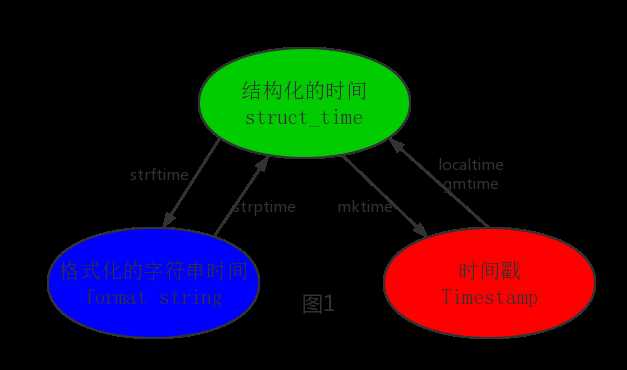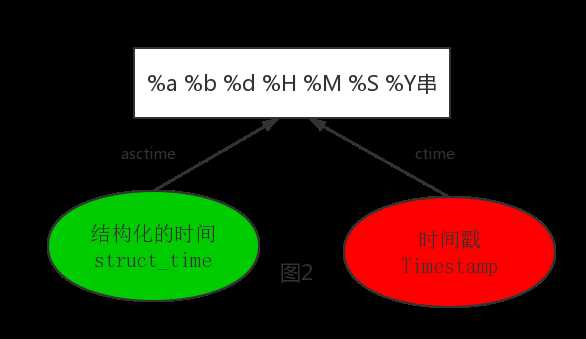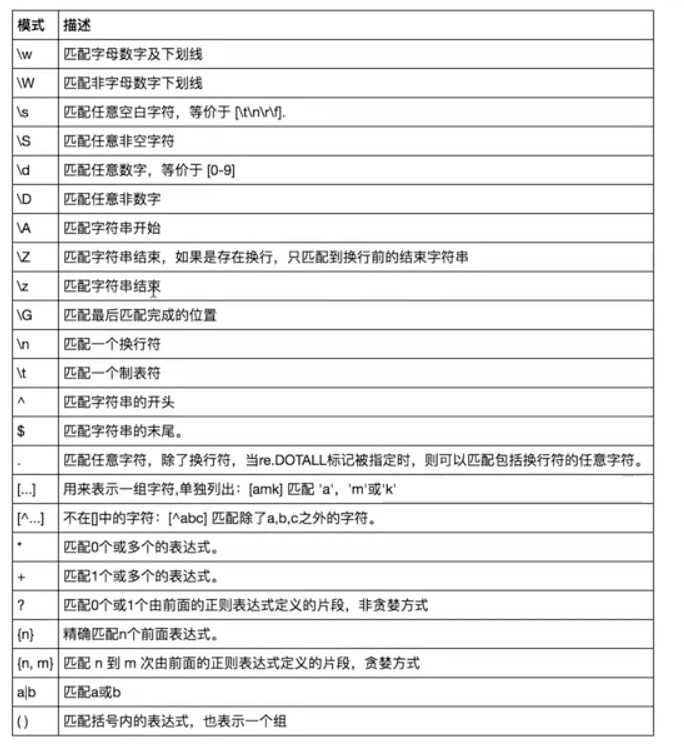标签:ecs 技术分享 环境变量 自定义log [1] iat 理解 空值 字节
在Python中,通常有这几种方式来表示时间:
import time #--------------------------我们先以当前时间为准,让大家快速认识三种形式的时间 print(time.time()) # 时间戳:1487130156.419527 print(time.strftime("%Y-%m-%d %X")) #格式化的时间字符串:‘2017-02-15 11:40:53‘ print(time.localtime()) #本地时区的struct_time print(time.gmtime()) #UTC时区的struct_time

1 %a Locale’s abbreviated weekday name. 2 %A Locale’s full weekday name. 3 %b Locale’s abbreviated month name. 4 %B Locale’s full month name. 5 %c Locale’s appropriate date and time representation. 6 %d Day of the month as a decimal number [01,31]. 7 %H Hour (24-hour clock) as a decimal number [00,23]. 8 %I Hour (12-hour clock) as a decimal number [01,12]. 9 %j Day of the year as a decimal number [001,366]. 10 %m Month as a decimal number [01,12]. 11 %M Minute as a decimal number [00,59]. 12 %p Locale’s equivalent of either AM or PM. (1) 13 %S Second as a decimal number [00,61]. (2) 14 %U Week number of the year (Sunday as the first day of the week) as a decimal number [00,53]. All days in a new year preceding the first Sunday are considered to be in week 0. (3) 15 %w Weekday as a decimal number [0(Sunday),6]. 16 %W Week number of the year (Monday as the first day of the week) as a decimal number [00,53]. All days in a new year preceding the first Monday are considered to be in week 0. (3) 17 %x Locale’s appropriate date representation. 18 %X Locale’s appropriate time representation. 19 %y Year without century as a decimal number [00,99]. 20 %Y Year with century as a decimal number. 21 %z Time zone offset indicating a positive or negative time difference from UTC/GMT of the form +HHMM or -HHMM, where H represents decimal hour digits and M represents decimal minute digits [-23:59, +23:59]. 22 %Z Time zone name (no characters if no time zone exists). 23 %% A literal ‘%‘ character. 24 格式化字符串的时间格式
其中计算机认识的时间只能是‘时间戳‘格式,而程序员可处理的或者说人类能看懂的时间有: ‘格式化的时间字符串‘,‘结构化的时间‘ ,于是有了下图的转换关系

#--------------------------按图1转换时间 # localtime([secs]) # 将一个时间戳转换为当前时区的struct_time。secs参数未提供,则以当前时间为准。 time.localtime() time.localtime(1473525444.037215) # gmtime([secs]) 和localtime()方法类似,gmtime()方法是将一个时间戳转换为UTC时区(0时区)的struct_time。 # mktime(t) : 将一个struct_time转化为时间戳。 print(time.mktime(time.localtime()))#1473525749.0 # strftime(format[, t]) : 把一个代表时间的元组或者struct_time(如由time.localtime()和 # time.gmtime()返回)转化为格式化的时间字符串。如果t未指定,将传入time.localtime()。如果元组中任何一个 # 元素越界,ValueError的错误将会被抛出。 print(time.strftime("%Y-%m-%d %X", time.localtime()))#2016-09-11 00:49:56 # time.strptime(string[, format]) # 把一个格式化时间字符串转化为struct_time。实际上它和strftime()是逆操作。 print(time.strptime(‘2011-05-05 16:37:06‘, ‘%Y-%m-%d %X‘)) #time.struct_time(tm_year=2011, tm_mon=5, tm_mday=5, tm_hour=16, tm_min=37, tm_sec=6, # tm_wday=3, tm_yday=125, tm_isdst=-1) #在这个函数中,format默认为:"%a %b %d %H:%M:%S %Y"。

#--------------------------按图2转换时间 # asctime([t]) : 把一个表示时间的元组或者struct_time表示为这种形式:‘Sun Jun 20 23:21:05 1993‘。 # 如果没有参数,将会将time.localtime()作为参数传入。 print(time.asctime())#Sun Sep 11 00:43:43 2016 # ctime([secs]) : 把一个时间戳(按秒计算的浮点数)转化为time.asctime()的形式。如果参数未给或者为 # None的时候,将会默认time.time()为参数。它的作用相当于time.asctime(time.localtime(secs))。 print(time.ctime()) # Sun Sep 11 00:46:38 2016 print(time.ctime(time.time())) # Sun Sep 11 00:46:38 2016
import random print(random.random())#(0,1)----float 大于0且小于1之间的小数 print(random.randint(1,3)) #[1,3] 大于等于1且小于等于3之间的整数 print(random.randrange(1,3)) #[1,3) 大于等于1且小于3之间的整数 print(random.choice([1,‘23‘,[4,5]]))#1或者23或者[4,5] print(random.sample([1,‘23‘,[4,5]],2))#列表元素任意2个组合 print(random.uniform(1,3))#大于1小于3的小数,如1.927109612082716 item=[1,3,5,7,9] random.shuffle(item) #打乱item的顺序,相当于"洗牌" print(item)
1 os.getcwd() 获取当前工作目录,即当前python脚本工作的目录路径 2 os.chdir("dirname") 改变当前脚本工作目录;相当于shell下cd 3 os.curdir 返回当前目录: (‘.‘) 4 os.pardir 获取当前目录的父目录字符串名:(‘..‘) 5 os.makedirs(‘dirname1/dirname2‘) 可生成多层递归目录 6 os.removedirs(‘dirname1‘) 若目录为空,则删除,并递归到上一级目录,如若也为空,则删除,依此类推 7 os.mkdir(‘dirname‘) 生成单级目录;相当于shell中mkdir dirname 8 os.rmdir(‘dirname‘) 删除单级空目录,若目录不为空则无法删除,报错;相当于shell中rmdir dirname 9 os.listdir(‘dirname‘) 列出指定目录下的所有文件和子目录,包括隐藏文件,并以列表方式打印 10 os.remove() 删除一个文件 11 os.rename("oldname","newname") 重命名文件/目录 12 os.stat(‘path/filename‘) 获取文件/目录信息 13 os.sep 输出操作系统特定的路径分隔符,win下为"\\",Linux下为"/" 14 os.linesep 输出当前平台使用的行终止符,win下为"\t\n",Linux下为"\n" 15 os.pathsep 输出用于分割文件路径的字符串 win下为;,Linux下为: 16 os.name 输出字符串指示当前使用平台。win->‘nt‘; Linux->‘posix‘ 17 os.system("bash command") 运行shell命令,直接显示 18 os.environ 获取系统环境变量 19 os.path.abspath(path) 返回path规范化的绝对路径 20 os.path.split(path) 将path分割成目录和文件名二元组返回 21 os.path.dirname(path) 返回path的目录。其实就是os.path.split(path)的第一个元素 22 os.path.basename(path) 返回path最后的文件名。如何path以/或\结尾,那么就会返回空值。即os.path.split(path)的第二个元素 23 os.path.exists(path) 如果path存在,返回True;如果path不存在,返回False 24 os.path.isabs(path) 如果path是绝对路径,返回True 25 os.path.isfile(path) 如果path是一个存在的文件,返回True。否则返回False 26 os.path.isdir(path) 如果path是一个存在的目录,则返回True。否则返回False 27 os.path.join(path1[, path2[, ...]]) 将多个路径组合后返回,第一个绝对路径之前的参数将被忽略 28 os.path.getatime(path) 返回path所指向的文件或者目录的最后存取时间 29 os.path.getmtime(path) 返回path所指向的文件或者目录的最后修改时间 30 os.path.getsize(path) 返回path的大小
在Linux和Mac平台上,该函数会原样返回path,在windows平台上会将路径中所有字符转换为小写,并将所有斜杠转换为饭斜杠。 >>> os.path.normcase(‘c:/windows\\system32\\‘) ‘c:\\windows\\system32\\‘ 规范化路径,如..和/ >>> os.path.normpath(‘c://windows\\System32\\../Temp/‘) ‘c:\\windows\\Temp‘ >>> a=‘/Users/jieli/test1/\\\a1/\\\\aa.py/../..‘ >>> print(os.path.normpath(a)) /Users/jieli/test1
四 sys模块
1 sys.argv 命令行参数List,第一个元素是程序本身路径 2 sys.exit(n) 退出程序,正常退出时exit(0) 3 sys.version 获取Python解释程序的版本信息 4 sys.maxint 最大的Int值 5 sys.path 返回模块的搜索路径,初始化时使用PYTHONPATH环境变量的值 6 sys.platform 返回操作系统平台名称

#=========知识储备========== #进度条的效果 [# ] [## ] [### ] [#### ] #指定宽度 print(‘[%-15s]‘ %‘#‘) print(‘[%-15s]‘ %‘##‘) print(‘[%-15s]‘ %‘###‘) print(‘[%-15s]‘ %‘####‘) #打印% print(‘%s%%‘ %(100)) #第二个%号代表取消第一个%的特殊意义 #可传参来控制宽度 print(‘[%%-%ds]‘ %50) #[%-50s] print((‘[%%-%ds]‘ %50) %‘#‘) print((‘[%%-%ds]‘ %50) %‘##‘) print((‘[%%-%ds]‘ %50) %‘###‘) #=========实现打印进度条函数========== import sys import time def progress(percent,width=50): if percent >= 1: percent=1 show_str=(‘[%%-%ds]‘ %width) %(int(width*percent)*‘#‘) print(‘\r%s %d%%‘ %(show_str,int(100*percent)),file=sys.stdout,flush=True,end=‘‘) #=========应用========== data_size=1025 recv_size=0 while recv_size < data_size: time.sleep(0.1) #模拟数据的传输延迟 recv_size+=1024 #每次收1024 percent=recv_size/data_size #接收的比例 progress(percent,width=70) #进度条的宽度70 打印进度条
之前我们学习过用eval内置方法可以将一个字符串转成python对象,不过,eval方法是有局限性的,对于普通的数据类型,json.loads和eval都能用,但遇到特殊类型的时候,eval就不管用了,所以eval的重点还是通常用来执行一个字符串表达式,并返回表达式的值
1 import json 2 x="[null,true,false,1]" 3 print(eval(x)) #报错,无法解析null类型,而json就可以 4 print(json.loads(x))
什么是序列化?
我们把对象(变量)从内存中变成可存储或传输的过程称之为序列化,在Python中叫pickling,在其他语言中也被称之为serialization,marshalling,flattening等等,都是一个意思。
为什么要序列化?
1:持久保存状态
需知一个软件/程序的执行就在处理一系列状态的变化,在编程语言中,‘状态‘会以各种各样有结构的数据类型(也可简单的理解为变量)的形式被保存在内存中。
内存是无法永久保存数据的,当程序运行了一段时间,我们断电或者重启程序,内存中关于这个程序的之前一段时间的数据(有结构)都被清空了。
在断电或重启程序之前将程序当前内存中所有的数据都保存下来(保存到文件中),以便于下次程序执行能够从文件中载入之前的数据,然后继续执行,这就是序列化。
具体的来说,你玩使命召唤闯到了第13关,你保存游戏状态,关机走人,下次再玩,还能从上次的位置开始继续闯关。或如,虚拟机状态的挂起等。
2:跨平台数据交互
序列化之后,不仅可以把序列化后的内容写入磁盘,还可以通过网络传输到别的机器上,如果收发的双方约定好实用一种序列化的格式,那么便打破了平台/语言差异化带来的限制,实现了跨平台数据交互。
反过来,把变量内容从序列化的对象重新读到内存里称之为反序列化,即unpickling。
如何序列化之json和pickle:
json
如果我们要在不同的编程语言之间传递对象,就必须把对象序列化为标准格式,比如XML,但更好的方法是序列化为JSON,因为JSON表示出来就是一个字符串,可以被所有语言读取,也可以方便地存储到磁盘或者通过网络传输。JSON不仅是标准格式,并且比XML更快,而且可以直接在Web页面中读取,非常方便。
JSON表示的对象就是标准的JavaScript语言的对象,JSON和Python内置的数据类型对应如下:
import json dic={‘name‘:‘alvin‘,‘age‘:23,‘sex‘:‘male‘} print(type(dic))#<class ‘dict‘> j=json.dumps(dic) print(type(j))#<class ‘str‘> f=open(‘序列化对象‘,‘w‘) f.write(j) #-------------------等价于json.dump(dic,f) f.close() #-----------------------------反序列化<br> import json f=open(‘序列化对象‘) data=json.loads(f.read())# 等价于data=json.load(f)
# 注释1 ; 注释2 [section1] k1 = v1 k2:v2 user=egon age=18 is_admin=true salary=31 [section2] k1 = v1
import configparser config=configparser.ConfigParser() config.read(‘a.cfg‘) #查看所有的标题 res=config.sections() #[‘section1‘, ‘section2‘] print(res) #查看标题section1下所有key=value的key options=config.options(‘section1‘) print(options) #[‘k1‘, ‘k2‘, ‘user‘, ‘age‘, ‘is_admin‘, ‘salary‘] #查看标题section1下所有key=value的(key,value)格式 item_list=config.items(‘section1‘) print(item_list) #[(‘k1‘, ‘v1‘), (‘k2‘, ‘v2‘), (‘user‘, ‘egon‘), (‘age‘, ‘18‘), (‘is_admin‘, ‘true‘), (‘salary‘, ‘31‘)] #查看标题section1下user的值=>字符串格式 val=config.get(‘section1‘,‘user‘) print(val) #egon #查看标题section1下age的值=>整数格式 val1=config.getint(‘section1‘,‘age‘) print(val1) #18 #查看标题section1下is_admin的值=>布尔值格式 val2=config.getboolean(‘section1‘,‘is_admin‘) print(val2) #True #查看标题section1下salary的值=>浮点型格式 val3=config.getfloat(‘section1‘,‘salary‘) print(val3) #31.0
改写
import configparser config=configparser.ConfigParser() config.read(‘a.cfg‘,encoding=‘utf-8‘) #删除整个标题section2 config.remove_section(‘section2‘) #删除标题section1下的某个k1和k2 config.remove_option(‘section1‘,‘k1‘) config.remove_option(‘section1‘,‘k2‘) #判断是否存在某个标题 print(config.has_section(‘section1‘)) #判断标题section1下是否有user print(config.has_option(‘section1‘,‘‘)) #添加一个标题 config.add_section(‘egon‘) #在标题egon下添加name=egon,age=18的配置 config.set(‘egon‘,‘name‘,‘egon‘) config.set(‘egon‘,‘age‘,18) #报错,必须是字符串 #最后将修改的内容写入文件,完成最终的修改 config.write(open(‘a.cfg‘,‘w‘))
hash:一种算法 ,3.x里代替了md5模块和sha模块,主要提供 SHA1, SHA224, SHA256, SHA384, SHA512 ,MD5 算法
三个特点:
1.内容相同则hash运算结果相同,内容稍微改变则hash值则变
2.不可逆推
3.相同算法:无论校验多长的数据,得到的哈希值长度固定。
import hashlib m=hashlib.md5()# m=hashlib.sha256() m.update(‘hello‘.encode(‘utf8‘)) print(m.hexdigest()) #5d41402abc4b2a76b9719d911017c592 m.update(‘alvin‘.encode(‘utf8‘)) print(m.hexdigest()) #92a7e713c30abbb0319fa07da2a5c4af m2=hashlib.md5() m2.update(‘helloalvin‘.encode(‘utf8‘)) print(m2.hexdigest()) #92a7e713c30abbb0319fa07da2a5c4af ‘‘‘ 注意:把一段很长的数据update多次,与一次update这段长数据,得到的结果一样 但是update多次为校验大文件提供了可能。 ‘‘‘
以上加密算法虽然依然非常厉害,但时候存在缺陷,即:通过撞库可以反解。所以,有必要对加密算法中添加自定义key再来做加密。
import hashlib # ######## 256 ######## hash = hashlib.sha256(‘898oaFs09f‘.encode(‘utf8‘)) hash.update(‘alvin‘.encode(‘utf8‘)) print (hash.hexdigest())#e79e68f070cdedcfe63eaf1a2e92c83b4cfb1b5c6bc452d214c1b7e77cdfd1c7
python 还有一个 hmac 模块,它内部对我们创建 key 和 内容 进行进一步的处理然后再加密:
1 import hmac 2 h = hmac.new(‘alvin‘.encode(‘utf8‘)) 3 h.update(‘hello‘.encode(‘utf8‘)) 4 print (h.hexdigest())#320df9832eab4c038b6c1d7ed73a5940
import subprocess ‘‘‘ sh-3.2# ls /Users/egon/Desktop |grep txt$ mysql.txt tt.txt 事物.txt ‘‘‘ res1=subprocess.Popen(‘ls /Users/jieli/Desktop‘,shell=True,stdout=subprocess.PIPE) res=subprocess.Popen(‘grep txt$‘,shell=True,stdin=res1.stdout, stdout=subprocess.PIPE) print(res.stdout.read().decode(‘utf-8‘)) #等同于上面,但是上面的优势在于,一个数据流可以和另外一个数据流交互,可以通过爬虫得到结果然后交给grep res1=subprocess.Popen(‘ls /Users/jieli/Desktop |grep txt$‘,shell=True,stdout=subprocess.PIPE) print(res1.stdout.read().decode(‘utf-8‘)) #windows下: # dir | findstr ‘test*‘ # dir | findstr ‘txt$‘ import subprocess res1=subprocess.Popen(r‘dir C:\Users\Administrator\PycharmProjects\test\函数备课‘,shell=True,stdout=subprocess.PIPE) res=subprocess.Popen(‘findstr test*‘,shell=True,stdin=res1.stdout, stdout=subprocess.PIPE) print(res.stdout.read().decode(‘gbk‘)) #subprocess使用当前系统默认编码,得到结果为bytes类型,在windows下需要用gbk解码
一 日志级别
CRITICAL = 50 #FATAL = CRITICAL ERROR = 40 WARNING = 30 #WARN = WARNING INFO = 20 DEBUG = 10 NOTSET = 0 #不设置
二 默认级别为warning,默认打印到终端
import logging logging.debug(‘调试debug‘) logging.info(‘消息info‘) logging.warning(‘警告warn‘) logging.error(‘错误error‘) logging.critical(‘严重critical‘) ‘‘‘ WARNING:root:警告warn ERROR:root:错误error CRITICAL:root:严重critical ‘‘‘
三 为logging模块指定全局配置,针对所有logger有效,控制打印到文件中

可在logging.basicConfig()函数中通过具体参数来更改logging模块默认行为,可用参数有 filename:用指定的文件名创建FiledHandler(后边会具体讲解handler的概念),这样日志会被存储在指定的文件中。 filemode:文件打开方式,在指定了filename时使用这个参数,默认值为“a”还可指定为“w”。 format:指定handler使用的日志显示格式。 datefmt:指定日期时间格式。 level:设置rootlogger(后边会讲解具体概念)的日志级别 stream:用指定的stream创建StreamHandler。可以指定输出到sys.stderr,sys.stdout或者文件,默认为sys.stderr。若同时列出了filename和stream两个参数,则stream参数会被忽略。 #格式 %(name)s:Logger的名字,并非用户名,详细查看 %(levelno)s:数字形式的日志级别 %(levelname)s:文本形式的日志级别 %(pathname)s:调用日志输出函数的模块的完整路径名,可能没有 %(filename)s:调用日志输出函数的模块的文件名 %(module)s:调用日志输出函数的模块名 %(funcName)s:调用日志输出函数的函数名 %(lineno)d:调用日志输出函数的语句所在的代码行 %(created)f:当前时间,用UNIX标准的表示时间的浮 点数表示 %(relativeCreated)d:输出日志信息时的,自Logger创建以 来的毫秒数 %(asctime)s:字符串形式的当前时间。默认格式是 “2003-07-08 16:49:45,896”。逗号后面的是毫秒 %(thread)d:线程ID。可能没有 %(threadName)s:线程名。可能没有 %(process)d:进程ID。可能没有 %(message)s:用户输出的消息 logging.basicConfig()

#======介绍 可在logging.basicConfig()函数中可通过具体参数来更改logging模块默认行为,可用参数有 filename:用指定的文件名创建FiledHandler(后边会具体讲解handler的概念),这样日志会被存储在指定的文件中。 filemode:文件打开方式,在指定了filename时使用这个参数,默认值为“a”还可指定为“w”。 format:指定handler使用的日志显示格式。 datefmt:指定日期时间格式。 level:设置rootlogger(后边会讲解具体概念)的日志级别 stream:用指定的stream创建StreamHandler。可以指定输出到sys.stderr,sys.stdout或者文件,默认为sys.stderr。若同时列出了filename和stream两个参数,则stream参数会被忽略。 format参数中可能用到的格式化串: %(name)s Logger的名字 %(levelno)s 数字形式的日志级别 %(levelname)s 文本形式的日志级别 %(pathname)s 调用日志输出函数的模块的完整路径名,可能没有 %(filename)s 调用日志输出函数的模块的文件名 %(module)s 调用日志输出函数的模块名 %(funcName)s 调用日志输出函数的函数名 %(lineno)d 调用日志输出函数的语句所在的代码行 %(created)f 当前时间,用UNIX标准的表示时间的浮 点数表示 %(relativeCreated)d 输出日志信息时的,自Logger创建以 来的毫秒数 %(asctime)s 字符串形式的当前时间。默认格式是 “2003-07-08 16:49:45,896”。逗号后面的是毫秒 %(thread)d 线程ID。可能没有 %(threadName)s 线程名。可能没有 %(process)d 进程ID。可能没有 %(message)s用户输出的消息 #========使用 import logging logging.basicConfig(filename=‘access.log‘, format=‘%(asctime)s - %(name)s - %(levelname)s -%(module)s: %(message)s‘, datefmt=‘%Y-%m-%d %H:%M:%S %p‘, level=10) logging.debug(‘调试debug‘) logging.info(‘消息info‘) logging.warning(‘警告warn‘) logging.error(‘错误error‘) logging.critical(‘严重critical‘) #========结果 access.log内容: 2017-07-28 20:32:17 PM - root - DEBUG -test: 调试debug 2017-07-28 20:32:17 PM - root - INFO -test: 消息info 2017-07-28 20:32:17 PM - root - WARNING -test: 警告warn 2017-07-28 20:32:17 PM - root - ERROR -test: 错误error 2017-07-28 20:32:17 PM - root - CRITICAL -test: 严重critical part2: 可以为logging模块指定模块级的配置,即所有logger的配置
四 logging模块的Formatter,Handler,Logger,Filter对象
#logger:产生日志的对象 #Filter:过滤日志的对象 #Handler:接收日志然后控制打印到不同的地方,FileHandler用来打印到文件中,StreamHandler用来打印到终端 #Formatter对象:可以定制不同的日志格式对象,然后绑定给不同的Handler对象使用,以此来控制不同的Handler的日志格式

‘‘‘ critical=50 error =40 warning =30 info = 20 debug =10 ‘‘‘ import logging #1、logger对象:负责产生日志,然后交给Filter过滤,然后交给不同的Handler输出 logger=logging.getLogger(__file__) #2、Filter对象:不常用,略 #3、Handler对象:接收logger传来的日志,然后控制输出 h1=logging.FileHandler(‘t1.log‘) #打印到文件 h2=logging.FileHandler(‘t2.log‘) #打印到文件 h3=logging.StreamHandler() #打印到终端 #4、Formatter对象:日志格式 formmater1=logging.Formatter(‘%(asctime)s - %(name)s - %(levelname)s -%(module)s: %(message)s‘, datefmt=‘%Y-%m-%d %H:%M:%S %p‘,) formmater2=logging.Formatter(‘%(asctime)s : %(message)s‘, datefmt=‘%Y-%m-%d %H:%M:%S %p‘,) formmater3=logging.Formatter(‘%(name)s %(message)s‘,) #5、为Handler对象绑定格式 h1.setFormatter(formmater1) h2.setFormatter(formmater2) h3.setFormatter(formmater3) #6、将Handler添加给logger并设置日志级别 logger.addHandler(h1) logger.addHandler(h2) logger.addHandler(h3) logger.setLevel(10) #7、测试 logger.debug(‘debug‘) logger.info(‘info‘) logger.warning(‘warning‘) logger.error(‘error‘) logger.critical(‘critical‘)
五 Logger与Handler的级别
logger是第一级过滤,然后才能到handler,我们可以给logger和handler同时设置level,但是需要注意的是

Logger is also the first to filter the message based on a level — if you set the logger to INFO, and all handlers to DEBUG, you still won‘t receive DEBUG messages on handlers — they‘ll be rejected by the logger itself. If you set logger to DEBUG, but all handlers to INFO, you won‘t receive any DEBUG messages either — because while the logger says "ok, process this", the handlers reject it (DEBUG < INFO). #验证 import logging form=logging.Formatter(‘%(asctime)s - %(name)s - %(levelname)s -%(module)s: %(message)s‘, datefmt=‘%Y-%m-%d %H:%M:%S %p‘,) ch=logging.StreamHandler() ch.setFormatter(form) # ch.setLevel(10) ch.setLevel(20) l1=logging.getLogger(‘root‘) # l1.setLevel(20) l1.setLevel(10) l1.addHandler(ch) l1.debug(‘l1 debug‘) 重要,重要,重要!!!
六 Logger的继承(了解)
import logging formatter=logging.Formatter(‘%(asctime)s - %(name)s - %(levelname)s -%(module)s: %(message)s‘, datefmt=‘%Y-%m-%d %H:%M:%S %p‘,) ch=logging.StreamHandler() ch.setFormatter(formatter) logger1=logging.getLogger(‘root‘) logger2=logging.getLogger(‘root.child1‘) logger3=logging.getLogger(‘root.child1.child2‘) logger1.addHandler(ch) logger2.addHandler(ch) logger3.addHandler(ch) logger1.setLevel(10) logger2.setLevel(10) logger3.setLevel(10) logger1.debug(‘log1 debug‘) logger2.debug(‘log2 debug‘) logger3.debug(‘log3 debug‘) ‘‘‘ 2017-07-28 22:22:05 PM - root - DEBUG -test: log1 debug 2017-07-28 22:22:05 PM - root.child1 - DEBUG -test: log2 debug 2017-07-28 22:22:05 PM - root.child1 - DEBUG -test: log2 debug 2017-07-28 22:22:05 PM - root.child1.child2 - DEBUG -test: log3 debug 2017-07-28 22:22:05 PM - root.child1.child2 - DEBUG -test: log3 debug 2017-07-28 22:22:05 PM - root.child1.child2 - DEBUG -test: log3 debug ‘‘‘
七 应用
""" logging配置 """ import os import logging.config # 定义三种日志输出格式 开始 standard_format = ‘[%(asctime)s][%(threadName)s:%(thread)d][task_id:%(name)s][%(filename)s:%(lineno)d]‘ ‘[%(levelname)s][%(message)s]‘ #其中name为getlogger指定的名字 simple_format = ‘[%(levelname)s][%(asctime)s][%(filename)s:%(lineno)d]%(message)s‘ id_simple_format = ‘[%(levelname)s][%(asctime)s] %(message)s‘ # 定义日志输出格式 结束 logfile_dir = os.path.dirname(os.path.abspath(__file__)) # log文件的目录 logfile_name = ‘all2.log‘ # log文件名 # 如果不存在定义的日志目录就创建一个 if not os.path.isdir(logfile_dir): os.mkdir(logfile_dir) # log文件的全路径 logfile_path = os.path.join(logfile_dir, logfile_name) # log配置字典 LOGGING_DIC = { ‘version‘: 1, ‘disable_existing_loggers‘: False, ‘formatters‘: { ‘standard‘: { ‘format‘: standard_format }, ‘simple‘: { ‘format‘: simple_format }, }, ‘filters‘: {}, ‘handlers‘: { #打印到终端的日志 ‘console‘: { ‘level‘: ‘DEBUG‘, ‘class‘: ‘logging.StreamHandler‘, # 打印到屏幕 ‘formatter‘: ‘simple‘ }, #打印到文件的日志,收集info及以上的日志 ‘default‘: { ‘level‘: ‘DEBUG‘, ‘class‘: ‘logging.handlers.RotatingFileHandler‘, # 保存到文件 ‘formatter‘: ‘standard‘, ‘filename‘: logfile_path, # 日志文件 ‘maxBytes‘: 1024*1024*5, # 日志大小 5M ‘backupCount‘: 5, ‘encoding‘: ‘utf-8‘, # 日志文件的编码,再也不用担心中文log乱码了 }, }, ‘loggers‘: { #logging.getLogger(__name__)拿到的logger配置 ‘‘: { ‘handlers‘: [‘default‘, ‘console‘], # 这里把上面定义的两个handler都加上,即log数据既写入文件又打印到屏幕 ‘level‘: ‘DEBUG‘, ‘propagate‘: True, # 向上(更高level的logger)传递 }, }, } def load_my_logging_cfg(): logging.config.dictConfig(LOGGING_DIC) # 导入上面定义的logging配置 logger = logging.getLogger(__name__) # 生成一个log实例 logger.info(‘It works!‘) # 记录该文件的运行状态 if __name__ == ‘__main__‘: load_my_logging_cfg() logging配置文件
""" MyLogging Test """ import time import logging import my_logging # 导入自定义的logging配置 logger = logging.getLogger(__name__) # 生成logger实例 def demo(): logger.debug("start range... time:{}".format(time.time())) logger.info("中文测试开始。。。") for i in range(10): logger.debug("i:{}".format(i)) time.sleep(0.2) else: logger.debug("over range... time:{}".format(time.time())) logger.info("中文测试结束。。。") if __name__ == "__main__": my_logging.load_my_logging_cfg() # 在你程序文件的入口加载自定义logging配置 demo() 使用
注意注意注意: #1、有了上述方式我们的好处是:所有与logging模块有关的配置都写到字典中就可以了,更加清晰,方便管理 #2、我们需要解决的问题是: 1、从字典加载配置:logging.config.dictConfig(settings.LOGGING_DIC) 2、拿到logger对象来产生日志 logger对象都是配置到字典的loggers 键对应的子字典中的 按照我们对logging模块的理解,要想获取某个东西都是通过名字,也就是key来获取的 于是我们要获取不同的logger对象就是 logger=logging.getLogger(‘loggers子字典的key名‘) 但问题是:如果我们想要不同logger名的logger对象都共用一段配置,那么肯定不能在loggers子字典中定义n个key ‘loggers‘: { ‘l1‘: { ‘handlers‘: [‘default‘, ‘console‘], # ‘level‘: ‘DEBUG‘, ‘propagate‘: True, # 向上(更高level的logger)传递 }, ‘l2: { ‘handlers‘: [‘default‘, ‘console‘ ], ‘level‘: ‘DEBUG‘, ‘propagate‘: False, # 向上(更高level的logger)传递 }, ‘l3‘: { ‘handlers‘: [‘default‘, ‘console‘], # ‘level‘: ‘DEBUG‘, ‘propagate‘: True, # 向上(更高level的logger)传递 }, } #我们的解决方式是,定义一个空的key ‘loggers‘: { ‘‘: { ‘handlers‘: [‘default‘, ‘console‘], ‘level‘: ‘DEBUG‘, ‘propagate‘: True, }, } 这样我们再取logger对象时 logging.getLogger(__name__),不同的文件__name__不同,这保证了打印日志时标识信息不同,但是拿着该名字去loggers里找key名时却发现找不到,于是默认使用key=‘‘的配置 !!!关于如何拿到logger对象的详细解释!!!
另外一个django的配置,瞄一眼就可以,跟上面的一样
#logging_config.py LOGGING = { ‘version‘: 1, ‘disable_existing_loggers‘: False, ‘formatters‘: { ‘standard‘: { ‘format‘: ‘[%(asctime)s][%(threadName)s:%(thread)d][task_id:%(name)s][%(filename)s:%(lineno)d]‘ ‘[%(levelname)s][%(message)s]‘ }, ‘simple‘: { ‘format‘: ‘[%(levelname)s][%(asctime)s][%(filename)s:%(lineno)d]%(message)s‘ }, ‘collect‘: { ‘format‘: ‘%(message)s‘ } }, ‘filters‘: { ‘require_debug_true‘: { ‘()‘: ‘django.utils.log.RequireDebugTrue‘, }, }, ‘handlers‘: { #打印到终端的日志 ‘console‘: { ‘level‘: ‘DEBUG‘, ‘filters‘: [‘require_debug_true‘], ‘class‘: ‘logging.StreamHandler‘, ‘formatter‘: ‘simple‘ }, #打印到文件的日志,收集info及以上的日志 ‘default‘: { ‘level‘: ‘INFO‘, ‘class‘: ‘logging.handlers.RotatingFileHandler‘, # 保存到文件,自动切 ‘filename‘: os.path.join(BASE_LOG_DIR, "xxx_info.log"), # 日志文件 ‘maxBytes‘: 1024 * 1024 * 5, # 日志大小 5M ‘backupCount‘: 3, ‘formatter‘: ‘standard‘, ‘encoding‘: ‘utf-8‘, }, #打印到文件的日志:收集错误及以上的日志 ‘error‘: { ‘level‘: ‘ERROR‘, ‘class‘: ‘logging.handlers.RotatingFileHandler‘, # 保存到文件,自动切 ‘filename‘: os.path.join(BASE_LOG_DIR, "xxx_err.log"), # 日志文件 ‘maxBytes‘: 1024 * 1024 * 5, # 日志大小 5M ‘backupCount‘: 5, ‘formatter‘: ‘standard‘, ‘encoding‘: ‘utf-8‘, }, #打印到文件的日志 ‘collect‘: { ‘level‘: ‘INFO‘, ‘class‘: ‘logging.handlers.RotatingFileHandler‘, # 保存到文件,自动切 ‘filename‘: os.path.join(BASE_LOG_DIR, "xxx_collect.log"), ‘maxBytes‘: 1024 * 1024 * 5, # 日志大小 5M ‘backupCount‘: 5, ‘formatter‘: ‘collect‘, ‘encoding‘: "utf-8" } }, ‘loggers‘: { #logging.getLogger(__name__)拿到的logger配置 ‘‘: { ‘handlers‘: [‘default‘, ‘console‘, ‘error‘], ‘level‘: ‘DEBUG‘, ‘propagate‘: True, }, #logging.getLogger(‘collect‘)拿到的logger配置 ‘collect‘: { ‘handlers‘: [‘console‘, ‘collect‘], ‘level‘: ‘INFO‘, } }, } # ----------- # 用法:拿到俩个logger logger = logging.getLogger(__name__) #线上正常的日志 collect_logger = logging.getLogger("collect") #领导说,需要为领导们单独定制领导们看的日志
一:什么是正则?
正则就是用一些具有特殊含义的符号组合到一起(称为正则表达式)来描述字符或者字符串的方法。或者说:正则就是用来描述一类事物的规则。(在Python中)它内嵌在Python中,并通过 re 模块实现。正则表达式模式被编译成一系列的字节码,然后由用 C 编写的匹配引擎执行。
生活中处处都是正则:
比如我们描述:4条腿
你可能会想到的是四条腿的动物或者桌子,椅子等
继续描述:4条腿,活的
就只剩下四条腿的动物这一类了
二:常用匹配模式(元字符)
http://blog.csdn.net/yufenghyc/article/details/51078107

# =================================匹配模式================================= #一对一的匹配 # ‘hello‘.replace(old,new) # ‘hello‘.find(‘pattern‘) #正则匹配 import re #\w与\W print(re.findall(‘\w‘,‘hello egon 123‘)) #[‘h‘, ‘e‘, ‘l‘, ‘l‘, ‘o‘, ‘e‘, ‘g‘, ‘o‘, ‘n‘, ‘1‘, ‘2‘, ‘3‘] print(re.findall(‘\W‘,‘hello egon 123‘)) #[‘ ‘, ‘ ‘] #\s与\S print(re.findall(‘\s‘,‘hello egon 123‘)) #[‘ ‘, ‘ ‘, ‘ ‘, ‘ ‘] print(re.findall(‘\S‘,‘hello egon 123‘)) #[‘h‘, ‘e‘, ‘l‘, ‘l‘, ‘o‘, ‘e‘, ‘g‘, ‘o‘, ‘n‘, ‘1‘, ‘2‘, ‘3‘] #\n \t都是空,都可以被\s匹配 print(re.findall(‘\s‘,‘hello \n egon \t 123‘)) #[‘ ‘, ‘\n‘, ‘ ‘, ‘ ‘, ‘\t‘, ‘ ‘] #\n与\t print(re.findall(r‘\n‘,‘hello egon \n123‘)) #[‘\n‘] print(re.findall(r‘\t‘,‘hello egon\t123‘)) #[‘\n‘] #\d与\D print(re.findall(‘\d‘,‘hello egon 123‘)) #[‘1‘, ‘2‘, ‘3‘] print(re.findall(‘\D‘,‘hello egon 123‘)) #[‘h‘, ‘e‘, ‘l‘, ‘l‘, ‘o‘, ‘ ‘, ‘e‘, ‘g‘, ‘o‘, ‘n‘, ‘ ‘] #\A与\Z print(re.findall(‘\Ahe‘,‘hello egon 123‘)) #[‘he‘],\A==>^ print(re.findall(‘123\Z‘,‘hello egon 123‘)) #[‘he‘],\Z==>$ #^与$ print(re.findall(‘^h‘,‘hello egon 123‘)) #[‘h‘] print(re.findall(‘3$‘,‘hello egon 123‘)) #[‘3‘] # 重复匹配:| . | * | ? | .* | .*? | + | {n,m} | #. print(re.findall(‘a.b‘,‘a1b‘)) #[‘a1b‘] print(re.findall(‘a.b‘,‘a1b a*b a b aaab‘)) #[‘a1b‘, ‘a*b‘, ‘a b‘, ‘aab‘] print(re.findall(‘a.b‘,‘a\nb‘)) #[] print(re.findall(‘a.b‘,‘a\nb‘,re.S)) #[‘a\nb‘] print(re.findall(‘a.b‘,‘a\nb‘,re.DOTALL)) #[‘a\nb‘]同上一条意思一样 #* print(re.findall(‘ab*‘,‘bbbbbbb‘)) #[] print(re.findall(‘ab*‘,‘a‘)) #[‘a‘] print(re.findall(‘ab*‘,‘abbbb‘)) #[‘abbbb‘] #? print(re.findall(‘ab?‘,‘a‘)) #[‘a‘] print(re.findall(‘ab?‘,‘abbb‘)) #[‘ab‘] #匹配所有包含小数在内的数字 print(re.findall(‘\d+\.?\d*‘,"asdfasdf123as1.13dfa12adsf1asdf3")) #[‘123‘, ‘1.13‘, ‘12‘, ‘1‘, ‘3‘] #.*默认为贪婪匹配 print(re.findall(‘a.*b‘,‘a1b22222222b‘)) #[‘a1b22222222b‘] #.*?为非贪婪匹配:推荐使用 print(re.findall(‘a.*?b‘,‘a1b22222222b‘)) #[‘a1b‘] #+ print(re.findall(‘ab+‘,‘a‘)) #[] print(re.findall(‘ab+‘,‘abbb‘)) #[‘abbb‘] #{n,m} print(re.findall(‘ab{2}‘,‘abbb‘)) #[‘abb‘] print(re.findall(‘ab{2,4}‘,‘abbb‘)) #[‘abb‘] print(re.findall(‘ab{1,}‘,‘abbb‘)) #‘ab{1,}‘ ===> ‘ab+‘ print(re.findall(‘ab{0,}‘,‘abbb‘)) #‘ab{0,}‘ ===> ‘ab*‘ #[] print(re.findall(‘a[1*-]b‘,‘a1b a*b a-b‘)) #[]内的都为普通字符了,且如果-没有被转意的话,应该放到[]的开头或结尾 print(re.findall(‘a[^1*-]b‘,‘a1b a*b a-b a=b‘)) #[]内的^代表的意思是取反,所以结果为[‘a=b‘] print(re.findall(‘a[0-9]b‘,‘a1b a*b a-b a=b‘)) #[]内的^代表的意思是取反,所以结果为[‘a=b‘] print(re.findall(‘a[a-z]b‘,‘a1b a*b a-b a=b aeb‘)) #[]内的^代表的意思是取反,所以结果为[‘a=b‘] print(re.findall(‘a[a-zA-Z]b‘,‘a1b a*b a-b a=b aeb aEb‘)) #[]内的^代表的意思是取反,所以结果为[‘a=b‘] #\# print(re.findall(‘a\\c‘,‘a\c‘)) #对于正则来说a\\c确实可以匹配到a\c,但是在python解释器读取a\\c时,会发生转义,然后交给re去执行,所以抛出异常 print(re.findall(r‘a\\c‘,‘a\c‘)) #r代表告诉解释器使用rawstring,即原生字符串,把我们正则内的所有符号都当普通字符处理,不要转义 print(re.findall(‘a\\\\c‘,‘a\c‘)) #同上面的意思一样,和上面的结果一样都是[‘a\\c‘] #():分组 print(re.findall(‘ab+‘,‘ababab123‘)) #[‘ab‘, ‘ab‘, ‘ab‘] print(re.findall(‘(ab)+123‘,‘ababab123‘)) #[‘ab‘],匹配到末尾的ab123中的ab print(re.findall(‘(?:ab)+123‘,‘ababab123‘)) #findall的结果不是匹配的全部内容,而是组内的内容,?:可以让结果为匹配的全部内容 #| print(re.findall(‘compan(?:y|ies)‘,‘Too many companies have gone bankrupt, and the next one is my company‘))
# ===========================re模块提供的方法介绍=========================== import re #1 print(re.findall(‘e‘,‘alex make love‘) ) #[‘e‘, ‘e‘, ‘e‘],返回所有满足匹配条件的结果,放在列表里 #2 print(re.search(‘e‘,‘alex make love‘).group()) #e,只到找到第一个匹配然后返回一个包含匹配信息的对象,该对象可以通过调用group()方法得到匹配的字符串,如果字符串没有匹配,则返回None。 #3 print(re.match(‘e‘,‘alex make love‘)) #None,同search,不过在字符串开始处进行匹配,完全可以用search+^代替match #4 print(re.split(‘[ab]‘,‘abcd‘)) #[‘‘, ‘‘, ‘cd‘],先按‘a‘分割得到‘‘和‘bcd‘,再对‘‘和‘bcd‘分别按‘b‘分割 #5 print(‘===>‘,re.sub(‘a‘,‘A‘,‘alex make love‘)) #===> Alex mAke love,不指定n,默认替换所有 print(‘===>‘,re.sub(‘a‘,‘A‘,‘alex make love‘,1)) #===> Alex make love print(‘===>‘,re.sub(‘a‘,‘A‘,‘alex make love‘,2)) #===> Alex mAke love print(‘===>‘,re.sub(‘^(\w+)(.*?\s)(\w+)(.*?\s)(\w+)(.*?)$‘,r‘\5\2\3\4\1‘,‘alex make love‘)) #===> love make alex print(‘===>‘,re.subn(‘a‘,‘A‘,‘alex make love‘)) #===> (‘Alex mAke love‘, 2),结果带有总共替换的个数 #6 obj=re.compile(‘\d{2}‘) print(obj.search(‘abc123eeee‘).group()) #12 print(obj.findall(‘abc123eeee‘)) #[‘12‘],重用了obj
#为何同样的表达式search与findall却有不同结果: print(re.search(‘\(([\+\-\*\/]*\d+\.?\d*)+\)‘,"1-12*(60+(-40.35/5)-(-4*3))").group()) #(-40.35/5) print(re.findall(‘\(([\+\-\*\/]*\d+\.?\d*)+\)‘,"1-12*(60+(-40.35/5)-(-4*3))")) #[‘/5‘, ‘*3‘] #看这个例子:(\d)+相当于(\d)(\d)(\d)(\d)...,是一系列分组 print(re.search(‘(\d)+‘,‘123‘).group()) #group的作用是将所有组拼接到一起显示出来 print(re.findall(‘(\d)+‘,‘123‘)) #findall结果是组内的结果,且是最后一个组的结果 search与findall
#_*_coding:utf-8_*_ __author__ = ‘Linhaifeng‘ #在线调试工具:tool.oschina.net/regex/# import re s=‘‘‘ http://www.baidu.com egon@oldboyedu.com 你好 010-3141 ‘‘‘ #最常规匹配 # content=‘Hello 123 456 World_This is a Regex Demo‘ # res=re.match(‘Hello\s\d\d\d\s\d{3}\s\w{10}.*Demo‘,content) # print(res) # print(res.group()) # print(res.span()) #泛匹配 # content=‘Hello 123 456 World_This is a Regex Demo‘ # res=re.match(‘^Hello.*Demo‘,content) # print(res.group()) #匹配目标,获得指定数据 # content=‘Hello 123 456 World_This is a Regex Demo‘ # res=re.match(‘^Hello\s(\d+)\s(\d+)\s.*Demo‘,content) # print(res.group()) #取所有匹配的内容 # print(res.group(1)) #取匹配的第一个括号内的内容 # print(res.group(2)) #去陪陪的第二个括号内的内容 #贪婪匹配:.*代表匹配尽可能多的字符 # import re # content=‘Hello 123 456 World_This is a Regex Demo‘ # # res=re.match(‘^He.*(\d+).*Demo$‘,content) # print(res.group(1)) #只打印6,因为.*会尽可能多的匹配,然后后面跟至少一个数字 #非贪婪匹配:?匹配尽可能少的字符 # import re # content=‘Hello 123 456 World_This is a Regex Demo‘ # # res=re.match(‘^He.*?(\d+).*Demo$‘,content) # print(res.group(1)) #只打印6,因为.*会尽可能多的匹配,然后后面跟至少一个数字 #匹配模式:.不能匹配换行符 content=‘‘‘Hello 123456 World_This is a Regex Demo ‘‘‘ # res=re.match(‘He.*?(\d+).*?Demo$‘,content) # print(res) #输出None # res=re.match(‘He.*?(\d+).*?Demo$‘,content,re.S) #re.S让.可以匹配换行符 # print(res) # print(res.group(1)) #转义:\ # content=‘price is $5.00‘ # res=re.match(‘price is $5.00‘,content) # print(res) # # res=re.match(‘price is \$5\.00‘,content) # print(res) #总结:尽量精简,详细的如下 # 尽量使用泛匹配模式.* # 尽量使用非贪婪模式:.*? # 使用括号得到匹配目标:用group(n)去取得结果 # 有换行符就用re.S:修改模式 #re.search:会扫描整个字符串,不会从头开始,找到第一个匹配的结果就会返回 # import re # content=‘Extra strings Hello 123 456 World_This is a Regex Demo Extra strings‘ # # res=re.match(‘Hello.*?(\d+).*?Demo‘,content) # print(res) #输出结果为None # # import re # content=‘Extra strings Hello 123 456 World_This is a Regex Demo Extra strings‘ # # res=re.search(‘Hello.*?(\d+).*?Demo‘,content) # # print(res.group(1)) #输出结果为 #re.search:只要一个结果,匹配演练, import re content=‘‘‘ <tbody> <tr id="4766303201494371851675" class="even "><td><div class="hd"><span class="num">1</span><div class="rk "><span class="u-icn u-icn-75"></span></div></div></td><td class="rank"><div class="f-cb"><div class="tt"><a href="/song?id=476630320"><img class="rpic" src="http://p1.music.126.net/Wl7T1LBRhZFg0O26nnR2iQ==/19217264230385030.jpg?param=50y50&quality=100"></a><span data-res-id="476630320" " # res=re.search(‘<a\shref=.*?<b\stitle="(.*?)".*?b>‘,content) # print(res.group(1)) #re.findall:找到符合条件的所有结果 # res=re.findall(‘<a\shref=.*?<b\stitle="(.*?)".*?b>‘,content) # for i in res: # print(i) #re.sub:字符串替换 import re content=‘Extra strings Hello 123 456 World_This is a Regex Demo Extra strings‘ # content=re.sub(‘\d+‘,‘‘,content) # print(content) #用\1取得第一个括号的内容 #用法:将123与456换位置 # import re # content=‘Extra strings Hello 123 456 World_This is a Regex Demo Extra strings‘ # # # content=re.sub(‘(Extra.*?)(\d+)(\s)(\d+)(.*?strings)‘,r‘\1\4\3\2\5‘,content) # content=re.sub(‘(\d+)(\s)(\d+)‘,r‘\3\2\1‘,content) # print(content) # import re # content=‘Extra strings Hello 123 456 World_This is a Regex Demo Extra strings‘ # # res=re.search(‘Extra.*?(\d+).*strings‘,content) # print(res.group(1)) # import requests,re # respone=requests.get(‘https://book.douban.com/‘).text # print(respone) # print(‘======‘*1000) # print(‘======‘*1000) # print(‘======‘*1000) # print(‘======‘*1000) # res=re.findall(‘<li.*?cover.*?href="(.*?)".*?title="(.*?)">.*?more-meta.*?author">(.*?)</span.*?year">(.*?)</span.*?publisher">(.*?)</span.*?</li>‘,respone,re.S) # # res=re.findall(‘<li.*?cover.*?href="(.*?)".*?more-meta.*?author">(.*?)</span.*?year">(.*?)</span.*?publisher">(.*?)</span>.*?</li>‘,respone,re.S) # # # for i in res: # print(‘%s %s %s %s‘ %(i[0].strip(),i[1].strip(),i[2].strip(),i[3].strip()))
标签:ecs 技术分享 环境变量 自定义log [1] iat 理解 空值 字节
原文地址:http://www.cnblogs.com/xu743876685/p/7745608.html